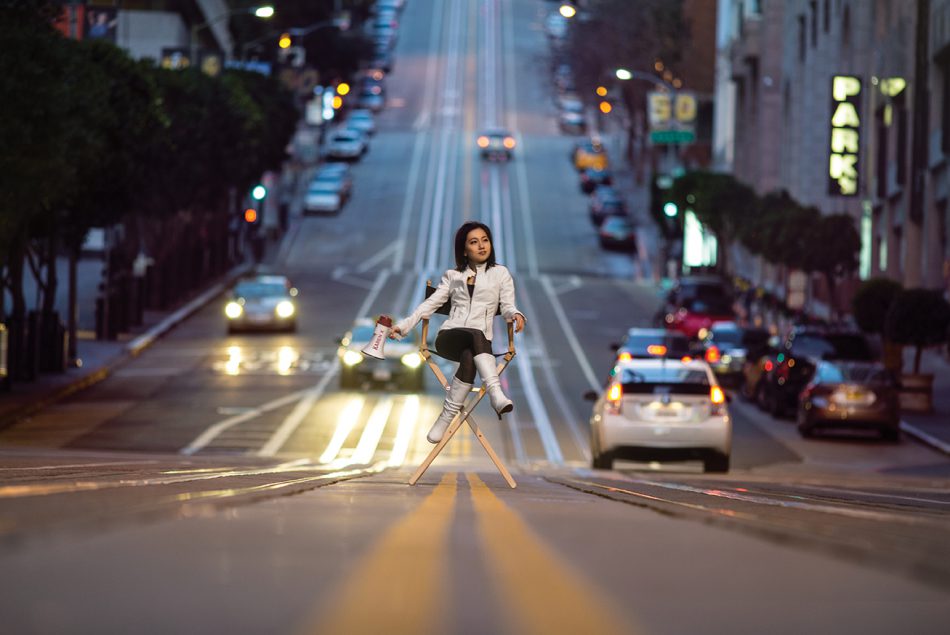
At the end of Seamus Heaney’s poem, “Oysters,” the speaker asks to be transformed into “pure verb.” Designer and videographer Karen X. Cheng embodies that phrase. Cheng runs Karen X, a creative agency that makes viral videos and commercials. A palpable sense of energy and activity pervades both her client work and her personal projects. Collectively, Cheng’s videos have over 100 million views, and her work has appeared on NBC, Good Morning America, and Ellen, among others. She has spoken at Google, TEDx, and Stanford, and her diverse range of clients includes Microsoft, Fiat, and Facebook. In late 2016, her TV spot for Beats by Dre premiered at the Thanksgiving Day football game.
One of Cheng’s first viral videos depicts a time lapse of Cheng teaching herself to dance over the course of a year. The bubbly music and living room setting of the video’s first half recalls the childhood levity of belting alone into one’s hair brush. But Cheng’s quotidian dedication to practicing, paired with the visual crescendo of her mesmerizing final dance sequence atop a BART platform, give the piece a narrative arc and a visceral appeal.
Cheng is at once a creative visionary and a didactic coach for those seeking to create highly shareable content. In our conversation about her career thus far, her answer to each of my questions contained a piece of advice befitting a designer graced with both a refreshing practicality and an incisive ability to identify the goals of any project and the means by which to achieve them.

What attracted you to video as a medium?
I started making videos in high school to capture car tricks and juggling that I was doing purely as a hobby. Video was the way to capture those things.
You have worked with a range of high-profile commercial clients. What does artistic integrity look like when you are aligning your creative vision with the needs of a brand?
When I’m doing client work I don’t see myself as an artist. The client has a goal and my job is to fulfill that goal. For my own personal projects I try to make work that is improving the world in some way and that will make people laugh or be inspiring. I don’t like to do mean prank videos. A good example of my personal projects is my dance video. After I released that video, I received thousands of emails from people who watched it and were inspired to learn a new skill.
You create viral content that is artful. What are some of the elements that you see as distinguishing excellent viral content from clickbait?
I guess clickbait or memes might give someone entertainment for a few minutes but I think excellent viral content is something that people will remember and talk about to their friends that’s how you know someone was impacted by something and that something was not just clickbait.
You say in a blog post that “people want stories.” What is the story that you have been most proud to tell in the context of your work? Is there a genre of story you tell over and over again?
A story that I’m proud to tell that I don’t tend to tell in my talks is the story of how I got into college. I was rejected from the college I wanted to go to and I emailed admissions and they said there was nothing I could do. I was persistent and asked to meet them and I drove three hours to the college, and met with them, laid out my case, and they were adamant about not letting me in. I said ‘if I put together an updated resume for you will you at least look at it?’-they agreed to that and I made this whole brochure and got it printed at Kinkos and I made a video and created a CD of all the information and I mailed them a bunch of copies. And then they called me and accepted me. I think there is always a way if you really want something, regardless of what systems and structures are in place.
If people discussed your body of work a generation from now, what would you want them to see as a defining characteristic of it?
I’m not far enough in my career to answer that question. I’m still experimenting and learning. A value I have is to evolve as video changes-the style of it and what makes content go viral. That is constantly changing, and it is important to pay attention.
You have written about how viral content tends to capture a strong emotion. Is there a time that you have made something from a particularly strong emotional starting point?
My dance video. I was so obsessed with learning how to dance. I had wanted to learn for 10 years. Everywhere I went, I was practicing. That was the most emotionally driven one for me, and it got the most responses of people who personally emailed me with their own story of learning a new skill.
If you could create a set of content that would shift a cultural norm, what cultural norm would you choose?
With America so polarized, I have wanted to create some content that would bridge people together politically. It is so challenging to create viral content on Facebook with that bridge effect; algorithmically you preach to the choir, and I haven’t figured out how to overcome that. If I could snap my fingers and simply make something that would serve as a bridge, I would.
Do you have any advice for people just starting out in videography?
Keep your day job. Making videos can pay well but there is a lot of groundwork that needs to be laid for that. I was doing videos as a hobby for many years. For a long time, it was this fun thing that I got to do and practice and become good at and then I could figure out how to make money from it.
Text Nina Foushee


